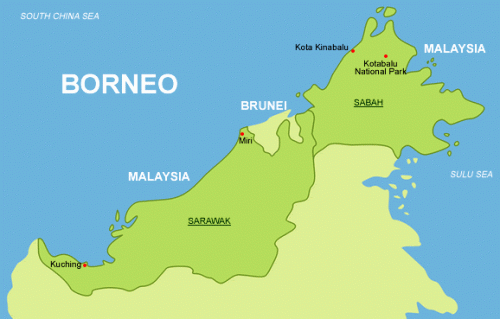|
Borneo, Sabah and Sarawak (East of Malaysia)
Situated in the heart of South East Asia just north of the equator between latitudes 1 deg and 7 deg N and longitudes 100 deg and 119 deg E, is a country of extraordinary and fascinating wonders. It is basically divided into two landmasses of East and West Malaysia.
West Malaysia, which is a peninsula of 131,587 sq kilometer in land area, shares its northern boundary with Thailand and is separated from Singapore at its southern end by the Johore Straits. East Malaysia, with a landmass of 198,847 sq kilometers, is located in the mystical island of Borneo.
Malaysia is administratively divided into 13 states of 11 of which are in West Malaysia - with Kuala Lumpur as federal Capital. The states of Sarawak and Sabah make up East Malaysia. About 80% of Malaysia's 22 million unique multi-racial population dwell in West Malaysia. Sarawak has population of about 21 million while Sabah has about 2.4 million.
Bahasa Malaysia is the official language in this country, but English is widely used as a second language.

Borneo Island
With a landmass that lays claim to being the world's 3rd largest island ( 743,812 sq km ), Borneo is surrounded by the Java Sea to south, the South China Sea to north and west, Sulu Sea and Celebes Sea to the East. The equator cuts approximately through the middle of the island, which is governed by three nations.
The two Malaysian states of Sarawak and Sabah occupy almost the entire northwest coast while the oil-rich kingdom of Brunei Darussalam is straddled near the northern coastline.
History of Borneo
The history of Borneo and its people has been largely determined by its strategic position at one of the world's major crossroads, its tropical climate, and north - east and south - east monsoons. Its geographical location served to make Borneo a "land bridge" to mainland South East Asia and an ideal meeting place for traders from East and West. The bountiful nature in the island contributed to the fact that Borneo was one of earliest homes of Man. Excavation works on the Niah Cave, which is a world famous archaeological site, had produced Paleolithic ( stone age ) implements and an ancient burial site carbon-dated to 40,000 B.C.
Although these findings provided strong evidence of Chinese and Indian civilizations having existed in Borneo since 1,500 years ago, the authenticated history of the island only began in comparatively recent times.
In 1368, after the fall of the Sri Vijaya Empire, Borneo war conquered by the Majapahit King ( Hindu Empire ). From about 1400 until the early sixteenth century, Muslim invaders began to spread their influence throughout the island. During the 1500s, a powerful kingdom known as Brunei exercised domination over the whole of Borneo and it surrounding area after the fall of the Majapahit Empire.
During that time, explorers and merchants from both the East and West visited Borneo. There are glowing accounts of the island trading chiefly in spices, rare woods, gold and precious tones and also experiencing a great deal of trouble with the coastal pirates.
In the late 1500s, the Dutch, Spanish, Portuguese and British appeared on the scene. They established prosperous trading posts in Borneo, and by the beginning of the nineteenth century, the kingdom of Brunei had shrunk to what we now know as Sarawak, Sabah and Brunei. Kalimantan was then under Dutch rule until 1949 when it ceded the territory to the Republic of Indonesia.
The state of Sarawak began to emerge as a separate political entity when an English adventurer, Sir James Brooks, war granted some territory in 1841 in return for his services in helping Brunei quell a rebellion in one of its provinces. The state of Sabah, on the other land, was under the rule of the Chartered Company of British North Borneo.
During the Second World War in 1941, the Japanese conquered the island. When the war ended, both Sabah and Sarawak were ceded to the British Government. The Malaysia concept was first announced by the late Tunku Abdul Rahman Putra Al-Haj, the Malayan Prime Minister, in May 1961. Nine month later, a British Commission visited Sarawak and Sabah and discovered that the majority of the people were in favour of concept.
Both states achieved full independence and joined the Federation of Malaysia in 1963.
|

